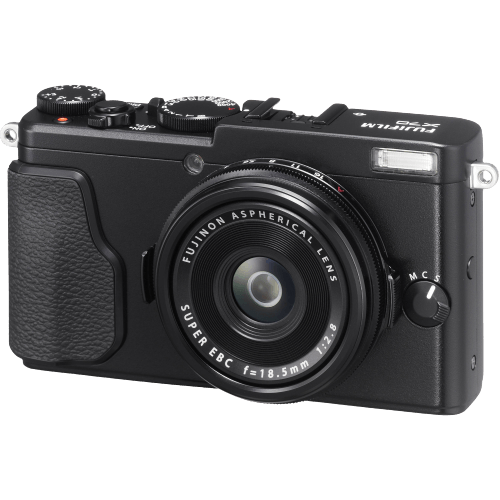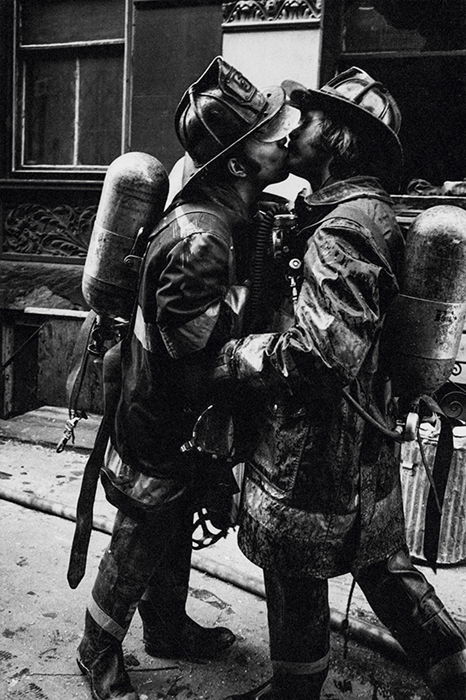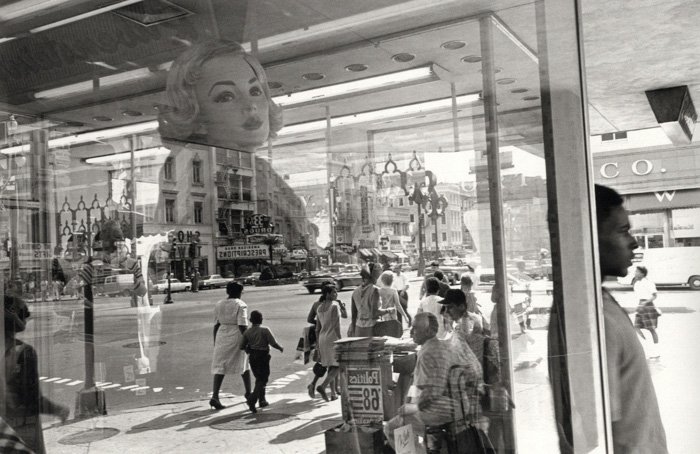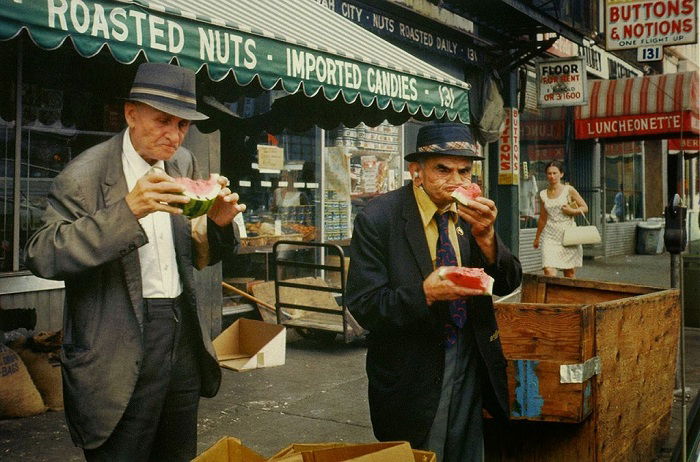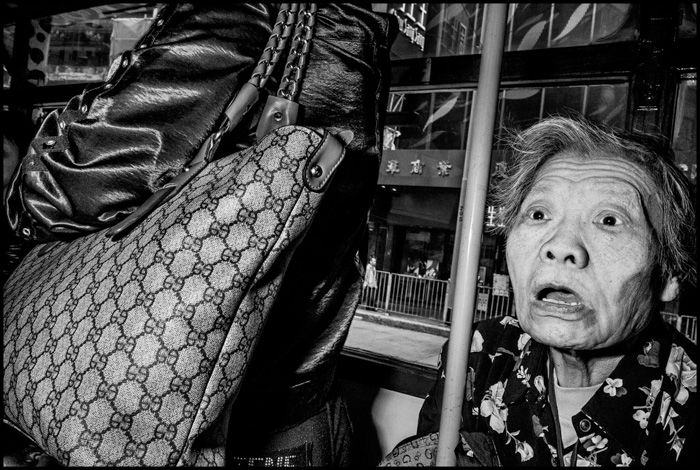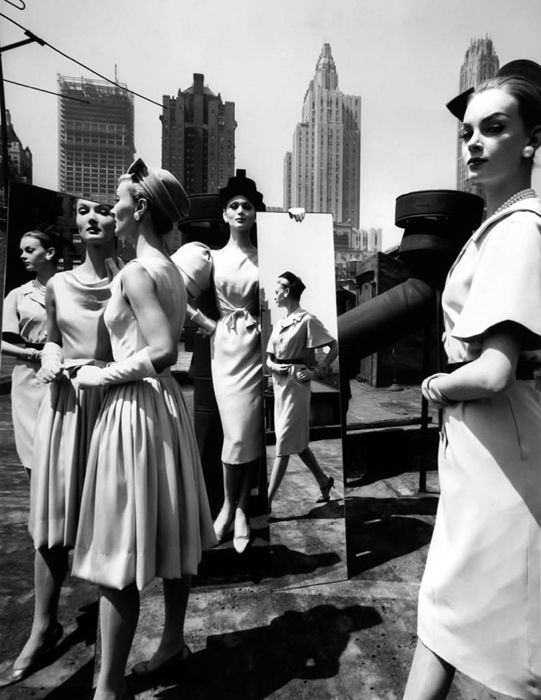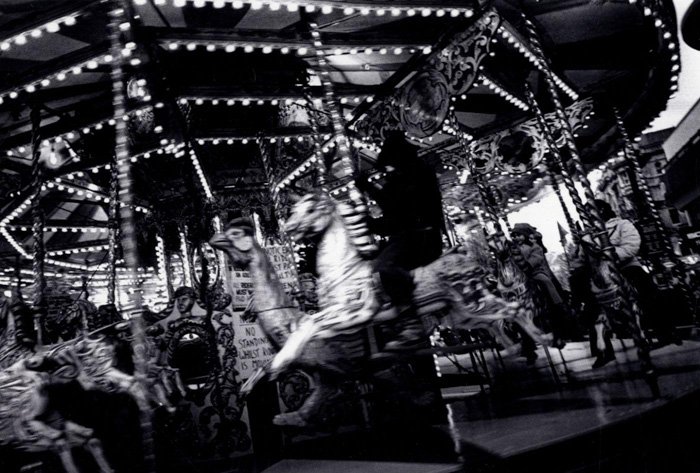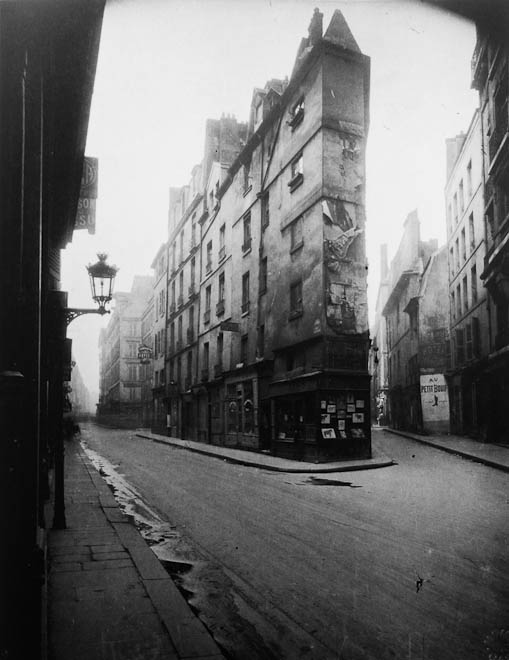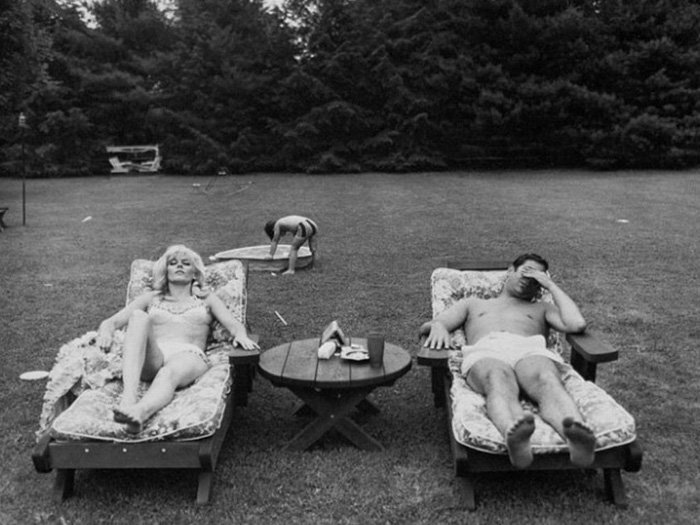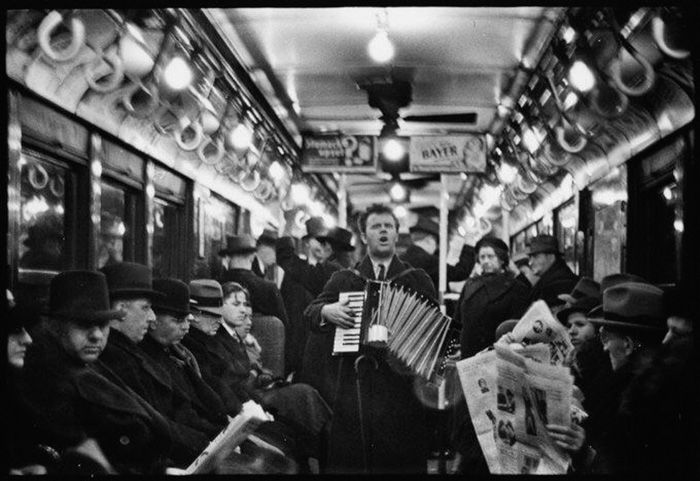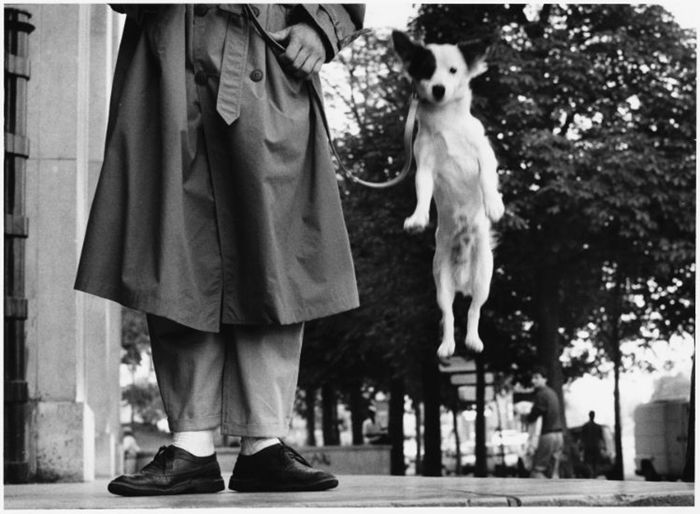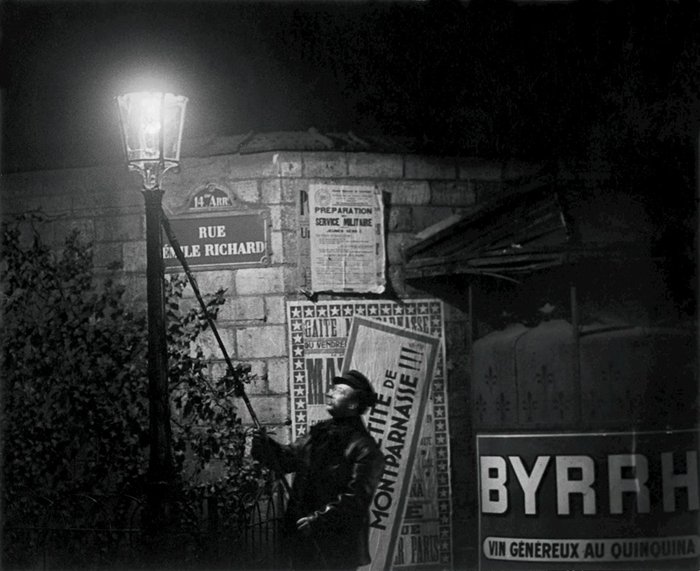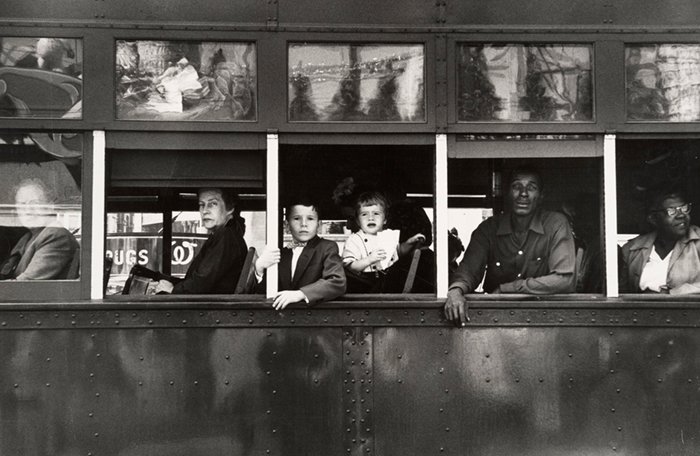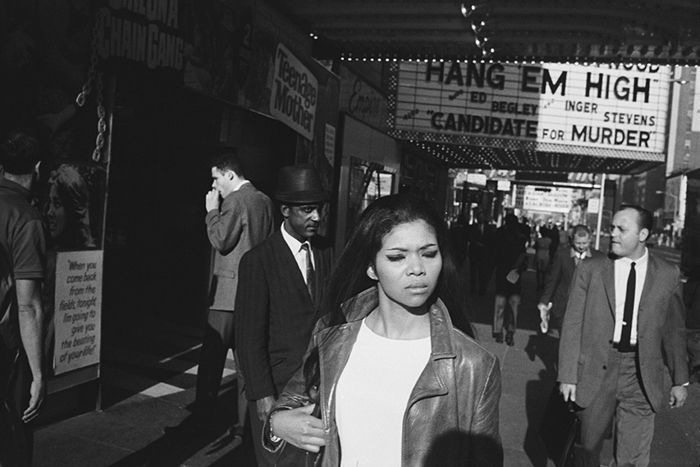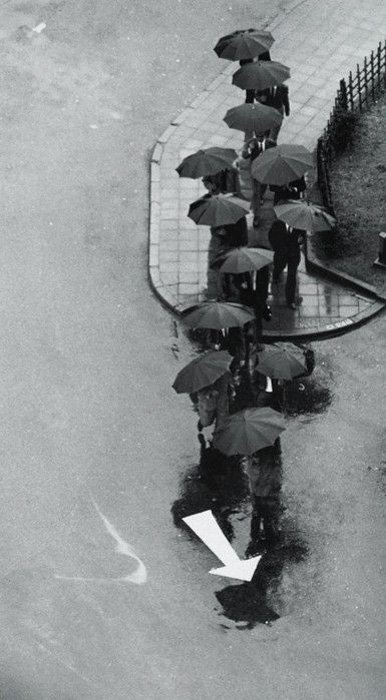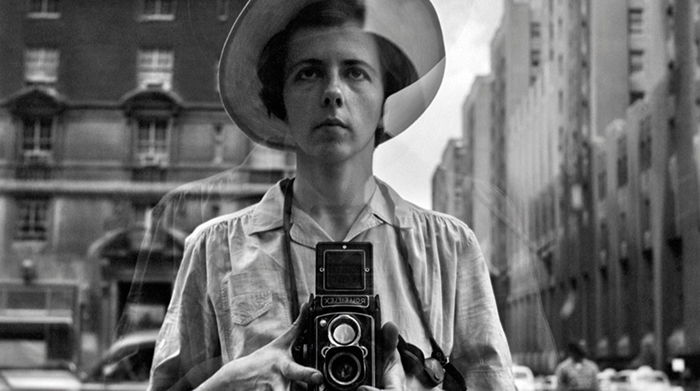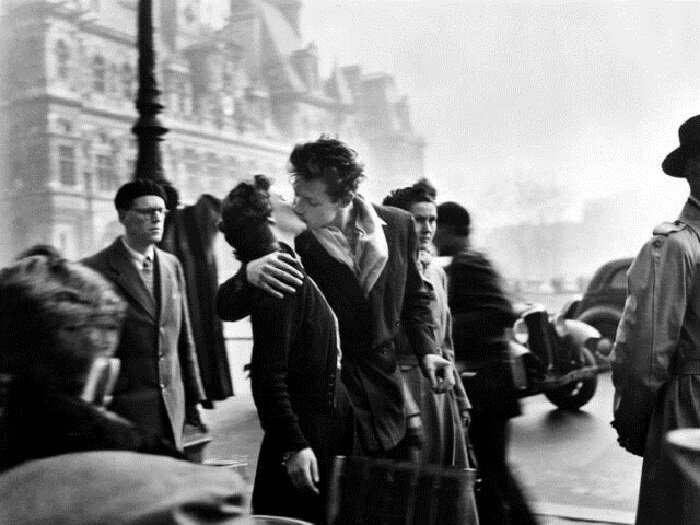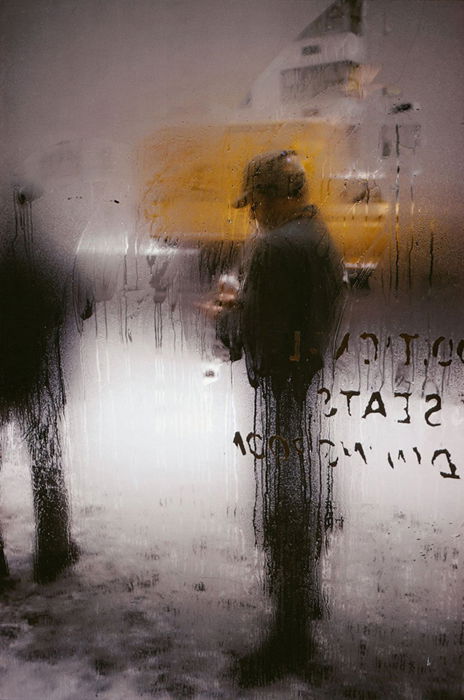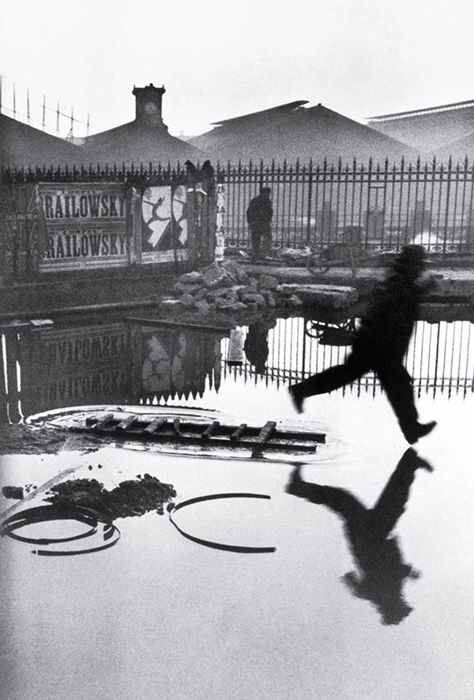One way to improve your street photography is by looking at the masters. With much difficulty, we’ve limited this list of famous street photographers to 20. Many worked in the mid- to late-20th century. Let’s look at the masters of street photography. Their stories and the stories they photographed. [ExpertPhotography is supported by readers. Product links on ExpertPhotography are referral links. If you use one of these and buy something, we make a little bit of money. Need more info? See how it all works here.]
20. Street Photographers: Dorothea Lange
Dorothea Lange (1895 – 1965) photographed in America during the Great Depression. Her image of a migrant mother in Nipomo, California became the iconic image of the era. Lange traveled the country, and later the world. She photographed poor rural farmers and unemployed working classes. Her goal was to shine a light on instances of social injustice. She brought empathy to her images; capturing a softness and compassion. See an overview of Lange’s work in the book Dorothea Lange: Photographs Of A Lifetime.
19. Jill Freedman
Jill Freedman’s (1939 – 2019) work hovers between street photography and photojournalism. Her subjects included marginalized populations and public servants. She photographed issues of social justice and political protests. Freedman immersed herself in her subjects. She joined the circus for two years, rode along with the New York City police, and lived with firefighters. Close relationships with her subjects allowed her to make personal, behind-the-scenes images. Her work was often under-appreciated. Yet she still is one of the most important street photographers. Each book is of Freedman’s images is a different project. Jill Freedman: Resurrection City, 1968 gives you a look into one of these projects.
18. Lee Friedlander
Lee Friedlander (1934 – ) captures the social landscape of cities. He photographs both the people on the streets and their urban environment. His subjects include storefronts, urban frames, and signage. These are the human artifacts of the modern world. Friedlander photographed a series of self-portraits beginning in the 1960s. He often captured himself in reflection or included his shadow in an image. The photographer becomes a participant in the scene. His black and white images capture a “snapshot aesthetic.” A quick, immediate documentation of a scene. The book Lee Friedlander is an introduction to the man and his images.
17. Helen Levitt
Helen Levitt (1913-2009) captures a poetic view of mid-20th century New York City. She photographed women, children and community street life. In her later career, she worked both in color and black and white. Her color images of the 1960s paved the way for other street photographers. Unfortunately, many of her color transparencies and prints from this period were stolen. Her images of the city are warm and approachable. They show a side of urban life full of community. Her pictures are vignettes of domestic life. Here and There is a collection of Levitt’s favourite images over seven decades of shooting.
16. Bruce Gilden
Bruce Gilden (1946 – ) is a controversial figure among urban photographers. He’s not just a candid photographer; he’s a confrontational one. Gilden doesn’t photograph people on the streets of New York as he finds them. He confronts his subjects. He jumps into their personal space with a wide-angle lens and a high-powered flash. This elicits a strong reaction; often one of surprise, sometimes anger. His portraits show an unfiltered, raw emotion. Gilden’s methods are often debated in the world of street photography. His method may be unorthodox, but the images he gets are unique. They show an immediate and direct intimacy with his subjects. The book Facing New York will give you a glimpse into Gilden’s style.
15. William Klein
William Klein (1928 – ) is an American-born, French-based street and fashion photographer. He often mixes the genres by photographing high fashion models on the streets. Klein shoots with a wide-angle lens in a quick and energetic style. His urban photography shows motion blur and grain. His is a world off-centre. He approaches street photography as an anthropologist. He captures the immediate culture of the urban lifestyle. He returned to his native New York as an American living in Paris. He photographed the rugged streets of the mid-1950s showing a harsh reality. The project culminated in the influential book Life is Good & Good for You in New York.
14. Daidō Moriyama
Daido Moriyama (1938 – ) is a Tokyo-based, Japanese street photographer. His street photography focuses on the conflict between traditional culture and the modern world. His style favours high-contrast, grainy images. His photos are often harsh and blurred, giving them an abstract quality. The tilted horizons and fragmentary compositions highlight urban angst. It’s difficult to recommend just one book by Moriyama. There are hundreds. Daido Moriyama: The World Through My Eyes is a curated collection and gives an overview of his work.
13. Eugène Atget
Eugène Atget (1857 – 1927) was possibly the first street photographer. Atget photographed the streets of Paris at the turn of the 20th century. He worked at a time when photography was rising in popularity. His photos were still lifes of the street. Often, the people behind the images were implied. Many of his photos are architectural with context. Atget’s work is not technically street photography, but he is cited by many later street photographers as a major influence. Championed by American photographer Berenice Abbott, his work became part of the mainstream. His work influenced the street photographers of the next generation. The book Paris Changing: Revisiting Eugene Atget’s Paris is a glimpse into Atget’s photography.
12. Diane Arbus
New York-based photographer Diane Arbus (1923 – 1971) is known for her street portraits. She focused on questions of identity and people living on the fringes of society. She photographed people who she saw as creating their own personal identities like performers, twins, and transvestites. She photographed subjects that were until that time forbidden. Some view Arbus’ images as compassionate portrayals of individuals. Others see them as bizarre and disturbing. She sought intense clarity in her pictures; showing the details of a secret life. Her estate carefully guarded her work for many years, but there are now many biographies. Diane Arbus: Photographer is an excellent place to start.
11. Walker Evans
Walker Evans (1903 – 1975) was a street photographer and photojournalist working in America. He captured his most famous work in the American south during the Great Depression of the 1930s. He photographed rural life and the small town. He captured both the poverty and the humanity of his subjects. His photographs document American culture of the time. Later, Evans would document unguarded moments on the New York Subway. In collaboration with the writer James Agee, Evans created the book Let Us Now Praise Famous Men. This classic book documented farm life in Alabama and contains some of Evans’ best work.
10. Elliott Erwitt
Elliott Erwitt (1928 – ) is an American street photographer. He captured life on the streets of New York and around the world during the mid- to late-20th century. He is famous for ironic and humorous street photographs. He was a master at finding candid moments that speak to us on an emotional level. Erwitt also photographed dogs. He devoted five books to dog photography. He also created iconic images of famous people, including Che Guevara. An excellent introduction to his work is Elliott Erwitt: Personal Best.
9. Brassaï – Gyula Halász
Brassaï (1899 – 1984) was born as Gyula Halász. During the 1920s and 1930s, photographed the nightlife of Paris. His photographs depicted the seedier side of the city. His subjects included prostitutes, transvestites, and the criminal underworld. He found stories not only on gritty streets but in Paris’ high society. He perfected the demanding technique of photographing life at night. The resulting images were moody and expressionistic. Brassaï’s first book, Paris by Night, compiled by him in 1933, remains one of the best introductions to his work.
8. Robert Frank
Swiss street photographer Robert Frank (1924 – 2019) is best known for his book The Americans. As an immigrant to the United States, Frank explored the back roads of his new country. He quickly became disillusioned by the commercialism and prejudice he encountered. His photographs of 1950s America later came to define the era. But they were initially dismissed as being too far removed from the mainstream. His photos were blurry, grainy, and dark in contrast to the images valued during the period. His look is referred to as “the snapshot aesthetic”. This personal, spontaneous look influenced later street photographers.
7. Garry Winogrand
Garry Winogrand (1928–1984) worked primarily in New York during the 1960s. He was both a street photographer and a photojournalist. He is known for his photographs of crowded public places including zoos and airports. His photos are filled with complex social interactions. Winogrand’s photographs capture the anxiety of the times. Particularly in the 1960s, his pictures show politics, society, and media colliding. Ironically, Winogrand hated the term “street photography”. He enjoyed the process of making the photograph above the final product. He left almost 2,500 rolls of film undeveloped at the time of his death. Winogrand is the subject of an award-winning documentary: Garry Winogrand: All Things Are Photographable. The Man in the Crowd: The Uneasy Streets of Garry Winogrand is an excellent introduction to his work.
6. André Kertész
André Kertész (1894 – 1985) inspired both street photographers and photojournalists. His work spans from the 1920s through the 1960s. He photographed the streets of Paris and New York. He explored unique camera angles and distortion. Though he influenced many 20th century photographers, including Cartier-Bresson, Kertész felt under-appreciated. His work was at the forefront of photography as an art form. Critics of the time struggled to place photography generally. Kertész’s photography specifically, alongside other forms of visual art. Kertész’s work is collected into several books. One of the best books to start with may be André Kertész: His Life and Work.
5. Fan Ho
Fan Ho (1931 – 2016) documented the Hong Kong street scene in the 1950s and 1960s. The city at the time was a very different place to what it became later in the century. He photographed the everyday life of children and workers in the side streets of the city. His photos are masterpieces of light and shadows; shapes and action. This leads some to call him the “Cartier-Bresson of the East”. Ho was a celebrated photographer, actor, and filmmaker during his lifetime. Books of Fan Ho’s works are difficult to come by, but keep your eyes out for Portrait of Hong Kong.
4. Vivian Maier
Unknown during her lifetime, Vivian Maier’s (1926 – 2009) is now one of the most famous street photographers. Collector John Maloof discovered hundreds of thousands of her negatives at an auction. He championed her photography; showing it to the world. The discovery is documented in the Academy Award-nominated film Finding Vivian Maier. Maier captured moments of street life, mostly in Chicago during the 1950s and 1960s. Her photos have a sense of gentleness and sometimes whimsy. Her subjects were diverse. She photographed children, the working class, and the wealthy on the street. She shot anything that caught her eye, including herself. There are many self-portraits in the collection; captured in reflections. Maier’s story, an unrecognized artist in our midsts, captured the world’s interest. But her story has also brought up issues of copyright and the ethics of publishing photos that were not shared by the artist herself. You can see her photos in many books, including Vivian Maier: Street Photographer.
3. Robert Doisneau
Many of Robert Doisneau’s (1912 – 1994) images showing the streets of mid-century Paris are icons. His photography was about capturing candid moments on the street. He favoured the odd moments in life; the funny juxtapositions or the romantic. One of his most famous images, Le Baiser de l’hôtel de Ville, also known as The Kiss, encapsulates French romance. A shy man, Doisneau first began capturing details of the street itself. Then he photographed children before moving onto adult subjects. For an introduction to Doisneau’s work, see the book Robert Doisneau (Icons) by Taschen.
2. Saul Leiter
Saul Leiter (1923 – 2013) was an American photographer working in the 1940s and 1950s. He photographed in black and white, but he is known as an early pioneer of color street photography. His images capture the quiet moments of the city. Soft focus and reflections give his pictures an impressionistic, painterly quality. Filmmaker Tomas Leach gives us an insight into the man and the photographer in the 2012 documentary: In No Great Hurry: 13 Lessons in Life with Saul Leiter. You can see Leiter’s photos in many books including the retrospective Saul Leiter by Vince Aletti and others.
1. Henri Cartier-Bresson
The most famous street photographer of all time is the French photographer Henri Cartier-Bresson (1908 – 2004). He is known for his candid photography and capturing the “decisive moment“. The decisive moment is the precise moment of action. It is the split-second of time that encapsulates all of the story shown in the image. In his own words, the decisive moment is: “…the simultaneous recognition, in a fraction of a second, of the significance of an event as well as of a precise organization of forms which give that event its proper expression.” Cartier-Bresson was well-travelled. He photographed in post-war Europe, Asia, and the American south. He was a founding member of Magnum Photos, a collection of photographs documenting life and events of the last 75 years. The organization has become significant in recognizing photographic talent. Cartier-Bresson inspires generations of photographers through his images and his philosophy of art. Books of Cartier-Bresson’s works are numerous. A good starting point is Henri Cartier-Bresson: Photographer.
Conclusion
Street photographers capture the emotions of life. They capture the quirky, and the surprised, the angry, and the bored. These 20 street photographers documented the world as they saw it – and as it was in a different era. We can look back on the work and walk the streets of cities that are no longer there. We can share in the lives of everyday people who look very different. But aren’t as different as we expected. For photography knowledge on-the-go, check out our Quick Capture Cheat Sheets!
